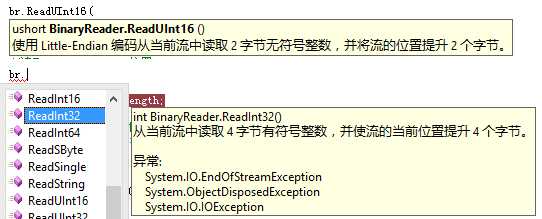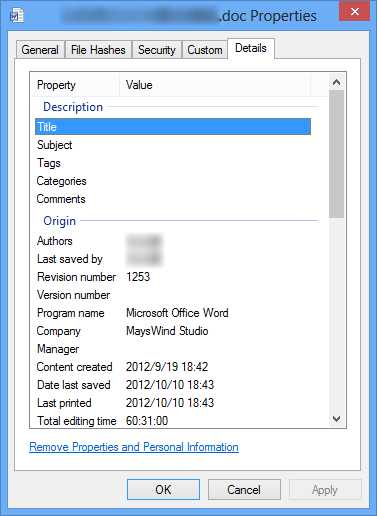标签:window coding system 反转 project 内容 解析 entry list
【系列索引】
【文章索引】
10年的时候参加比赛要做一个文件检索的系统,要包含Word、PowerPoint等文件格式的全文检索。由于之前用过.NET并且考虑到这些是微软的格式,可能使用.NET读取会更容易些,但没想到.NET这边查到的资料只有Interop的方式读取Office文件。后来接触了Java的POI,发现.NET也有移植的NPOI,但是只移植了核心的Excel读写,并没有Word、PowerPoint等文件的读写,所以最后没有办法只能硬着头皮自己去做Word和PowerPoint文件的解析。
那么Interop是什么?Interop的全称是“Interoperability”,即微软希望托管的.NET能与非托管的COM进行互相调用的一种方式。通过Interop读写Office即调用安装在计算机上的Office软件来实现Office的读写,其优点显而易见,文件还是由Office生成或读取的,所以与自己打开Office是没有任何区别的;但缺点也非常明显,即运行程序的计算机上必须安装有对应版本的Office软件,同时操作Office文件时实际上是打开了对应的Office组件,所以运行效率低、耗内存大并且还可能产生内存泄露的问题。关于Interop方式读写Office文件的例子网上有很多,有兴趣的可以自行查阅,这里就不再多讲了。
那么,有没有方式不借助Office软件实现Office文件的读写呢?答案肯定是肯定的,就像Java中的POI及.NET中的NPOI实现的那样,即通过程序自己读写文件来实现Office文件的读写。不过由于Office文件结构非常复杂,这里只提供文件摘要信息和文件文本内容的解析。不过即使如此,对于全文检索什么的还是足够的。
前几年,微软开放了一些私有格式的规范,使得所有人都可以对其文件进行解析,而不需要支付任何费用,这也使得我们编写解析文件的程序成为可能,相关链接在文章最后可以找到。对于一个Microsoft Office文件,其实质是一个Windows复合二进制文件(Windows Compound Binary File),文件的头Header是固定的512字节,Header记录文件最重要的参数。Header之后可以分为不同的Sector,Sector的种类有FAT、Mini-FAT(属于Mini-Sector)、Directory、DIF、Stroage等五种。为了方便称呼,我们规定每个Sector都有一个SectorID,Header后的Sector为第一个Sector,其SectorID为0。
我们先来说Header,一个Header的部分截图及包含的信息如下,比较重要的用粗体表示。

那么我们可以写如下的代码将Header中重要的内容解析出来。
#region 字段
private FileStream m_stream;
private BinaryReader m_reader;
private Int64 m_length;
private DirectoryEntry m_dirRootEntry;
#region 头部信息
private UInt32 m_sectorSize;//Sector大小
private UInt32 m_miniSectorSize;//Mini-Sector大小
private UInt32 m_fatCount;//FAT数量
private UInt32 m_dirStartSectorID;//Directory开始的SectorID
private UInt32 m_miniFatStartSectorID;//Mini-FAT开始的SectorID
private UInt32 m_miniFatCount;//Mini-FAT数量
private UInt32 m_difStartSectorID;//DIF开始的SectorID
private UInt32 m_difCount;//DIF数量
#endregion
#endregion
#region 读取头部信息
private void ReadHeader()
{
if (this.m_reader == null)
{
return;
}
//先判断是否是Office文件格式
Byte[] sig = (this.m_length > 512 ? this.m_reader.ReadBytes(8) : null);
if (sig == null ||
sig[0] != 0xD0 || sig[1] != 0xCF || sig[2] != 0x11 || sig[3] != 0xE0 ||
sig[4] != 0xA1 || sig[5] != 0xB1 || sig[6] != 0x1A || sig[7] != 0xE1)
{
throw new Exception("该文件不是Office文件!");
}
//读取头部信息
this.m_stream.Seek(22, SeekOrigin.Current);
this.m_sectorSize = (UInt32)Math.Pow(2, this.m_reader.ReadUInt16());
this.m_miniSectorSize = (UInt32)Math.Pow(2, this.m_reader.ReadUInt16());
this.m_stream.Seek(10, SeekOrigin.Current);
this.m_fatCount = this.m_reader.ReadUInt32();
this.m_dirStartSectorID = this.m_reader.ReadUInt32();
this.m_stream.Seek(8, SeekOrigin.Current);
this.m_miniFatStartSectorID = this.m_reader.ReadUInt32();
this.m_miniFatCount = this.m_reader.ReadUInt32();
this.m_difStartSectorID = this.m_reader.ReadUInt32();
this.m_difCount = this.m_reader.ReadUInt32();
}
#endregion
说个比较有意思的,.NET中的BinaryReader有很多读取的方法,比如ReadUInt16、ReadInt32之类的,只有ReadUInt16的Summary写着“使用 Little-Endian 编码...”(见下图),其实不仅仅是ReadUInt16,所有ReadIntX、ReadUIntX、ReadSingle、ReadDouble都是使用Little-Endian编码方式从流中读的,大家可以放心使用,而不需要一个字节一个字节的读再反转数组,我在10年的时候就走过弯路。解释在MSDN各个方法中的备注里:http://msdn.microsoft.com/zh-cn/library/vstudio/system.io.binaryreader_methods.aspx

复合文档中其实存放着很多内容,这么多内容需要有个目录,那么Directory就是这个目录。从Header中我们可以读取出Directory开始的SectorID,我们可以Seek到这个位置(0x200 + sectorSize * dirStartSectorID)。Directory中每个DirectoryEntry固定为128字节,其主要结构如下:
显然,Directory其实是一个树形的结构,我们只要从第一个Entry(Root Entry)开始递归搜索就可以了。
为了方便开发,我们创建一个DirectoryEntry的类
public enum DirectoryEntryType : byte
{
Invalid = 0,
Storage = 1,
Stream = 2,
LockBytes = 3,
Property = 4,
Root = 5
}
public class DirectoryEntry
{
#region 字段
private UInt32 m_entryID;
private String m_entryName;
private DirectoryEntryType m_entryType;
private UInt32 m_sectorID;
private UInt32 m_length;
private DirectoryEntry m_parent;
private List<DirectoryEntry> m_children;
#endregion
#region 属性
/// <summary>
/// 获取DirectoryEntry的EntryID
/// </summary>
public UInt32 EntryID
{
get { return this.m_entryID; }
}
/// <summary>
/// 获取DirectoryEntry名称
/// </summary>
public String EntryName
{
get { return this.m_entryName; }
}
/// <summary>
/// 获取DirectoryEntry类型
/// </summary>
public DirectoryEntryType EntryType
{
get { return this.m_entryType; }
}
/// <summary>
/// 获取DirectoryEntry的SectorID
/// </summary>
public UInt32 SectorID
{
get { return this.m_sectorID; }
}
/// <summary>
/// 获取DirectoryEntry的内容大小
/// </summary>
public UInt32 Length
{
get { return this.m_length; }
}
/// <summary>
/// 获取DirectoryEntry的父节点
/// </summary>
public DirectoryEntry Parent
{
get { return this.m_parent; }
}
/// <summary>
/// 获取DirectoryEntry的子节点
/// </summary>
public List<DirectoryEntry> Children
{
get { return this.m_children; }
}
#endregion
#region 构造函数
/// <summary>
/// 初始化新的DirectoryEntry
/// </summary>
/// <param name="parent">父节点</param>
/// <param name="entryID">DirectoryEntryID</param>
/// <param name="entryName">DirectoryEntry名称</param>
/// <param name="entryType">DirectoryEntry类型</param>
/// <param name="sectorID">SectorID</param>
/// <param name="length">内容大小</param>
public DirectoryEntry(DirectoryEntry parent, UInt32 entryID, String entryName, DirectoryEntryType entryType, UInt32 sectorID, UInt32 length)
{
this.m_entryID = entryID;
this.m_entryName = entryName;
this.m_entryType = entryType;
this.m_sectorID = sectorID;
this.m_length = length;
this.m_parent = parent;
if (entryType == DirectoryEntryType.Root || entryType == DirectoryEntryType.Storage)
{
this.m_children = new List<DirectoryEntry>();
}
}
#endregion
#region 方法
public void AddChild(DirectoryEntry entry)
{
if (this.m_children == null)
{
this.m_children = new List<DirectoryEntry>();
}
this.m_children.Add(entry);
}
public DirectoryEntry GetChild(String entryName)
{
for (Int32 i = 0; i < this.m_children.Count; i++)
{
if (String.Equals(this.m_children[i].EntryName, entryName))
{
return this.m_children[i];
}
}
return null;
}
#endregion
}
然后我们递归搜索就可以了
【四、DocumentSummaryInformation和SummaryInformation】
Office文档包含很多摘要信息,比如标题、作者、编辑时间等等,如下图。

摘要信息又分为两类,一类是DocumentSummaryInformation,另一类是SummaryInformation,分别包含不同种类的摘要信息。通过上述的代码应该能获取到Root Entry下有一个叫“\005DocumentSummaryInformation”的Entry和一个叫“\005SummaryInformation”的Entry。
对于DocumentSummaryInformation,其结构如下
对于每个属性组,其结构如下:
常见的属性编号有以下这些:
 View Code
View Code对于每个属性,其结构如下:
为了方便开发,我们创建一个DocumentSummary的类。比较有意思的是,不论DocumentSummaryInformation还是SummaryInformation,第一个属性都是记录该组内容的代码页编码,可以通过Encoding.GetEncoding()获取对应的编码然后用GetString把对应的字符串解析出来:
 View Code
View Code然后我们进行读取就可以了:
 View Code
View Code而SummaryInformation与DocumentSummaryInformation相比读取方式是一样的,只不过属性组的16位标识为0xE0 0x85 0x9F 0xF2 0xF9 0x4F 0x68 0x10 0xAB 0x91 0x08 0x00 0x2B 0x27 0xB3 0xD9。
常见的SummaryInformation属性的属性编号如下:
 View Code
View Code其他代码由于与DocumentSummaryInformation相近就不再单独给出了。
附,本文所有代码下载:https://github.com/mayswind/SimpleOfficeReader
#region 常量
private const UInt32 HeaderSize = 0x200;//512字节
private const UInt32 DirectoryEntrySize = 0x80;//128字节
#endregion
#region 读取目录信息
private void ReadDirectory()
{
if (this.m_reader == null)
{
return;
}
UInt32 leftSiblingEntryID, rightSiblingEntryID, childEntryID;
this.m_dirRootEntry = GetDirectoryEntry(0, null, out leftSiblingEntryID, out rightSiblingEntryID, out childEntryID);
this.ReadDirectoryEntry(this.m_dirRootEntry, childEntryID);
}
private void ReadDirectoryEntry(DirectoryEntry rootEntry, UInt32 entryID)
{
UInt32 leftSiblingEntryID, rightSiblingEntryID, childEntryID;
DirectoryEntry entry = GetDirectoryEntry(entryID, rootEntry, out leftSiblingEntryID, out rightSiblingEntryID, out childEntryID);
if (entry == null || entry.EntryType == DirectoryEntryType.Invalid)
{
return;
}
rootEntry.AddChild(entry);
if (leftSiblingEntryID < UInt32.MaxValue)//有左兄弟节点
{
this.ReadDirectoryEntry(rootEntry, leftSiblingEntryID);
}
if (rightSiblingEntryID < UInt32.MaxValue)//有右兄弟节点
{
this.ReadDirectoryEntry(rootEntry, rightSiblingEntryID);
}
if (childEntryID < UInt32.MaxValue)//有孩子节点
{
this.ReadDirectoryEntry(entry, childEntryID);
}
}
private DirectoryEntry GetDirectoryEntry(UInt32 entryID, DirectoryEntry parentEntry, out UInt32 leftSiblingEntryID, out UInt32 rightSiblingEntryID, out UInt32 childEntryID)
{
leftSiblingEntryID = UInt16.MaxValue;
rightSiblingEntryID = UInt16.MaxValue;
childEntryID = UInt16.MaxValue;
this.m_stream.Seek(GetDirectoryEntryOffset(entryID), SeekOrigin.Begin);
if (this.m_stream.Position >= this.m_length)
{
return null;
}
StringBuilder temp = new StringBuilder();
for (Int32 i = 0; i < 32; i++)
{
temp.Append((Char)this.m_reader.ReadUInt16());
}
UInt16 nameLen = this.m_reader.ReadUInt16();
String name = (temp.ToString(0, (temp.Length < (nameLen / 2 - 1) ? temp.Length : nameLen / 2 - 1)));
Byte type = this.m_reader.ReadByte();
if (type > 5)
{
return null;
}
this.m_stream.Seek(1, SeekOrigin.Current);
leftSiblingEntryID = this.m_reader.ReadUInt32();
rightSiblingEntryID = this.m_reader.ReadUInt32();
childEntryID = this.m_reader.ReadUInt32();
this.m_stream.Seek(36, SeekOrigin.Current);
UInt32 sectorID = this.m_reader.ReadUInt32();
UInt32 length = this.m_reader.ReadUInt32();
return new DirectoryEntry(parentEntry, entryID, name, (DirectoryEntryType)type, sectorID, length);
}
#endregion
#region 辅助方法
private Int64 GetSectorOffset(UInt32 sectorID)
{
return HeaderSize + this.m_sectorSize * sectorID;
}
private Int64 GetDirectoryEntryOffset(UInt32 sectorID)
{
return HeaderSize + this.m_sectorSize * this.m_dirStartSectorID + DirectoryEntrySize * sectorID;
}
#endregion
1、Microsoft Open Specifications:http://www.microsoft.com/openspecifications/en/us/programs/osp/default.aspx
2、用PHP读取MS Word(.doc)中的文字:https://imethan.com/post-2009-10-06-17-59.html
3、Office檔案格式:http://www.programmer-club.com.tw/ShowSameTitleN/general/2681.html
4、LAOLA file system:http://stuff.mit.edu/afs/athena/astaff/project/mimeutils/share/laola/guide.html
【后记】
花了好几天的时间才写完读取DocumentSummaryInformation和SummaryInformation,果然自己写程序用和写成文章区别太大了,前者差不多就行,后者还得仔细查阅资料。如果您觉得好就点下推荐呗。
转载:http://www.cnblogs.com/mayswind/archive/2013/03/17/2962205.html
Office文件的奥秘——.NET平台下不借助Office实现Word、Powerpoint等文件的解析(一)
标签:window coding system 反转 project 内容 解析 entry list
原文地址:http://www.cnblogs.com/ONDragon/p/7280315.html